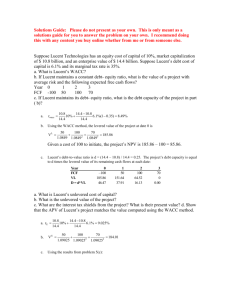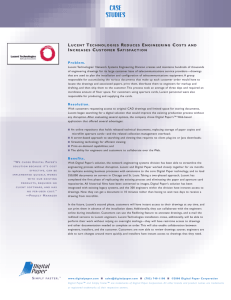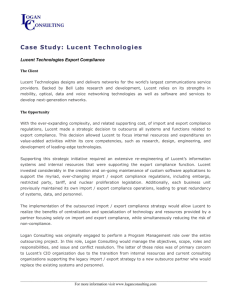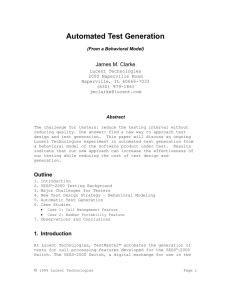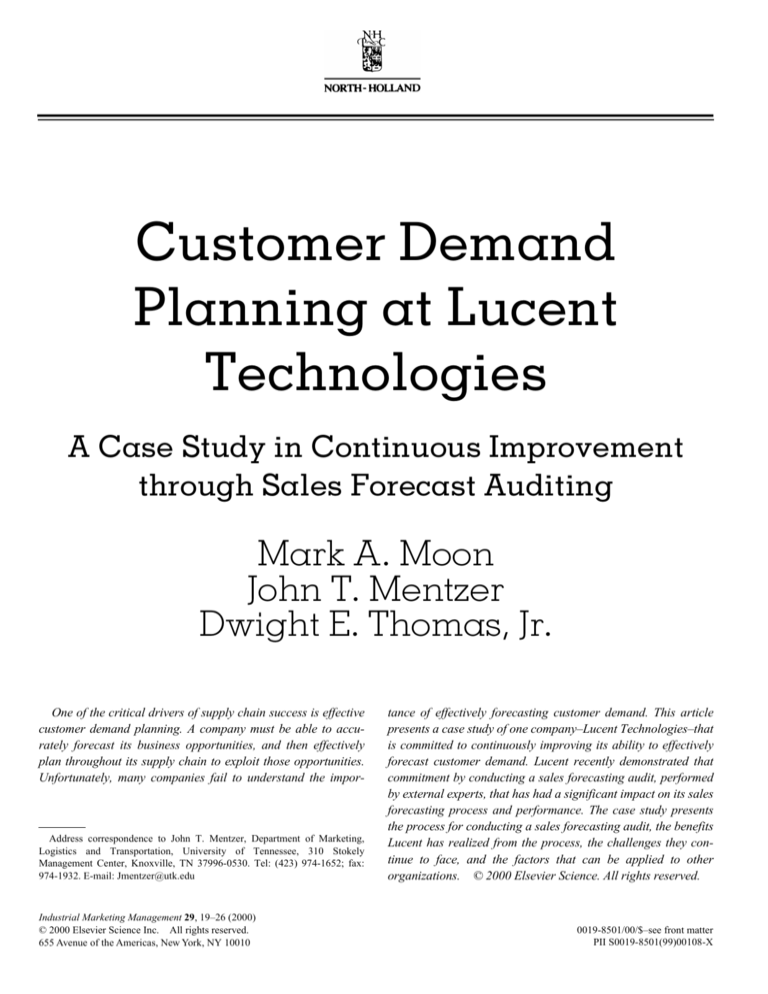
Customer Demand
Planning at Lucent
Technologies
A Case Study in Continuous Improvement
through Sales Forecast Auditing
Mark A. Moon
John T. Mentzer
Dwight E. Thomas, Jr.
One of the critical drivers of supply chain success is effective
customer demand planning. A company must be able to accurately forecast its business opportunities, and then effectively
plan throughout its supply chain to exploit those opportunities.
Unfortunately, many companies fail to understand the impor-
Address correspondence to John T. Mentzer, Department of Marketing,
Logistics and Transportation, University of Tennessee, 310 Stokely
Management Center, Knoxville, TN 37996-0530. Tel: (423) 974-1652; fax:
974-1932. E-mail: Jmentzer@utk.edu
Industrial Marketing Management 29, 19–26 (2000)
© 2000 Elsevier Science Inc. All rights reserved.
655 Avenue of the Americas, New York, NY 10010
tance of effectively forecasting customer demand. This article
presents a case study of one company–Lucent Technologies–that
is committed to continuously improving its ability to effectively
forecast customer demand. Lucent recently demonstrated that
commitment by conducting a sales forecasting audit, performed
by external experts, that has had a significant impact on its sales
forecasting process and performance. The case study presents
the process for conducting a sales forecasting audit, the benefits
Lucent has realized from the process, the challenges they continue to face, and the factors that can be applied to other
organizations. © 2000 Elsevier Science. All rights reserved.
0019-8501/00/$–see front matter
PII S0019-8501(99)00108-X
Customer demand planning is essential for
supply chain coordination.
INTRODUCTION
One of the critical drivers of supply chain success is
effective customer demand planning. A company must
be able to accurately forecast its business opportunities,
and then effectively plan throughout its supply chain so it
can exploit those opportunities [1].
Unfortunately, many organizations fail to recognize
the top- and bottom-line effects of poor customer demand
planning. From a top-line perspective, companies cannot
take advantage of demand for their products and services
if, first, they fail to accurately forecast that demand and,
second, they fail to develop and implement appropriate
plans to build the required supply chain capacity to fulfill
that demand. From a bottom-line perspective, effective
customer demand planning allows a company to minimize its supply chain costs by minimizing inventory, purchasing, logistics, and production costs.
One large industrial company that has recognized the
leverage available from effective customer demand planning is Lucent Technologies. The purpose of this paper is
to describe the process improvements that Lucent Technologies has undertaken over the last several years, as
well as the challenges that they continue to face. This
company’s experiences help to point out principles of effective customer demand planning that will allow other
organizations to improve their management of this critical business process. It will also describe an audit process
that has helped Lucent Technologies identify opportuni-
MARK A. MOON is a faculty member in the Department of
Marketing, Logistics & Transportation, the University of
Tennessee, Knoxville, Tennessee.
JOHN T. MENTZER is the Harry J. & Vivienne R. Bruce
Excellence Chair of Business Policy in the Department of
Marketing, Logistics & Transportation, the University of
Tennessee, Knoxville, Tennessee.
DWIGHT E. THOMAS, JR. is a senior logistics executive at
Lucent Technologies.
20
ties for improvement, and provided a platform upon
which fundamental organizational change can occur.
COMPANY BACKGROUND
Lucent Technologies was formed in 1995 when AT&T
divided into three major businesses. What used to be several manufacturing units within AT&T, including Network Systems, combined with Bell Labs to become a
new company called Lucent Technologies. Lucent Technologies primary product families now consist of Systems for Network Operators (revenues for the 12-month
period ending September 30, 1998 of $18.8 billion);
Business Communication Systems ($8.1 billion); and
Microelectronic Products ($3.0 billion). As a result of its
recent merger with Ascend Communications, Lucent is
now one of the leading global suppliers of data networking systems. Other major product lines include switching
and access systems, wireless communications systems,
optical networking systems, and fiber optic systems.
CUSTOMER DEMAND PLANNING
Lucent Technologies has established an organization,
as well as a core business process, called Customer Demand Planning (CDP). The CDP process is defined as a
business planning process enabling sales teams (and customers) to develop product/application demand forecasts
as inputs to inventory and production planning, revenue
planning, and services planning processes.
This definition indicates that Lucent Technologies has
an enlightened view of the separate, yet interconnected,
roles of forecasting and business planning. Many companies use the terms forecasting and planning almost interchangeably, but Lucent recognizes that they are separate,
and sequential, processes. Forecasting is seen at Lucent
as the process of developing the most probable view of
what the level of future demand will be, given a set of assumptions about technology, competitors, pricing, marketing expenditures, and sales efforts. Planning, on the

